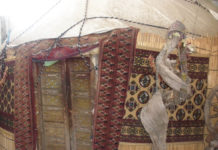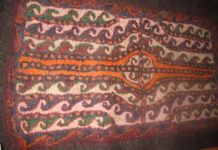Yurt is a brilliant architectural design of nomadic culture. Optimal convenience of its structure fully reflects the dynamism of nomadic life and the philosophy of a person living in harmony with nature and recognising itself as its integral part. Created entirely from natural materials, flexible willow branches serving as a material for the wooden frame, and thick felt impermeable to rains and the sun, covering the wooden frame, the yurt keeps the air cool in the heat and protects from wind, rain and snow during the cold season.
The oldest images of the yurt are found on the burial statuettes of Northern China of first millennium AD. Researchers attribute the invention of the yurt to that particular period.
There are two types of yurt: Mongolian and Turkic. The Turkic yurt, which includes the Kazakh, Kyrgyz, Turkmen and Uzbek, differs from the Mongolian one by having curved dome poles. This dismisses the use of support columns and frees the inner space of the yurt.
The yurt fully meets the needs of the nomad due to its convenience and practicality. It quickly assembles and is easily disassembled by one family within an hour, easily transported by camels, horses or a car and its felt cover protects from rain, wind and cold. In the countries of Central Asia, the yurt is still actively used by livestock keepers, and in recent years it has been successfully used in the tourism industry.
In contemporary Kyrgyz language, the yurt is called boz uy (gray house) or Kyrgyz uy (Kyrgyz house). The basis of the yurt is a wooden frame consisting of a folding latticed wall (kerege), dome poles (uuk) and a rim on the dome of the yurt, which holds the poles and is also a chimney (tunduk). The frame of the yurt is made of willow, osier bed, poplar and tunduk is made of soft birch. Wood is processed manually using primitive tools made by craftsmen themselves. To mount and attach the movable wooden parts of the yurt, straps of rawhide are used.

The yurt frame is bound tightly for strength by patterned woven strips (bo’o). Behind the lattice wall, the yurt is banded around the perimeter with a striped or patterned reed screen (kanat chii). The yurt is covered with felt sheets that are 1-1.5 centimeters thick and cut in accordance with its size. The height of the yurt is 3-3.5 meters. Size of the Kyrgyz yurt varies from 5 to 7.5 meters in diameter.
Entrance to the yurt is covered with reed mat with ornamented felt attached from the outside. Sometimes an internal double-leafed wooden door, decorated with carvings, is used.
The yurt is divided into two sections: male and female. On the male section, located to the left of the entrance, one can find belongings associated with livestock, horse harness and hunting gear. On the female part of the yurt, to the right of the entrance, there is a kitchen area with dishes and food. The earthen floor of the yurt is covered with felted and woven carpets, animal skins and various mats. On the walls, one can find embroidered panel (tush-kiyiz) or strap-on shelves (tekche). Kolomoto (hearth) is in the centre of the yurt. Opposite the entrance, behind the hearth, there is tor, an honourable place for guests to be seated. It is also where chests with valuables are stored, blankets piled, pillows and carpets are stacked. It is a place to sleep as well.
Nowadays yurts in Kyrgyzstan are produced primarily in Issyk-Kul region, in the villages of Kyzyl Tuu, Barskoon and Semenovka. In 2014 the yurt has been inscribed to UNESCO’s Representative List of Intangible Cultural Heritage of Humanity. Renowned masters are Jylkychy Sharshembiev, Orozobai Kenchenbaev and Mirlan Isayev.





